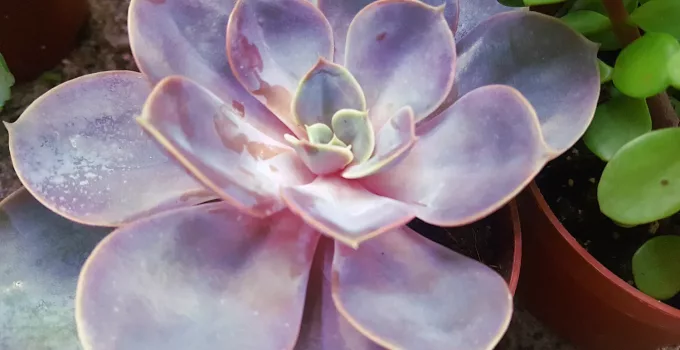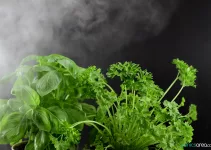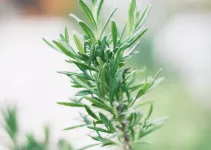If you are looking for an explosion of color, you definitely need to be paying attention to succulents with purple flowers as well as to succulents that turn purple through their leaves changing color.
Cacti are also part of the vast world of succulents, comprised of over 40 botanical families. There are some beautiful cacti that bloom purple, as well. These succulents with purple flowers or purple leaves can also be added to beautiful succulent gift boxes.
Table of Contents
The Most Beautiful Succulents with Purple Flowers and Succulents that Turn Purple
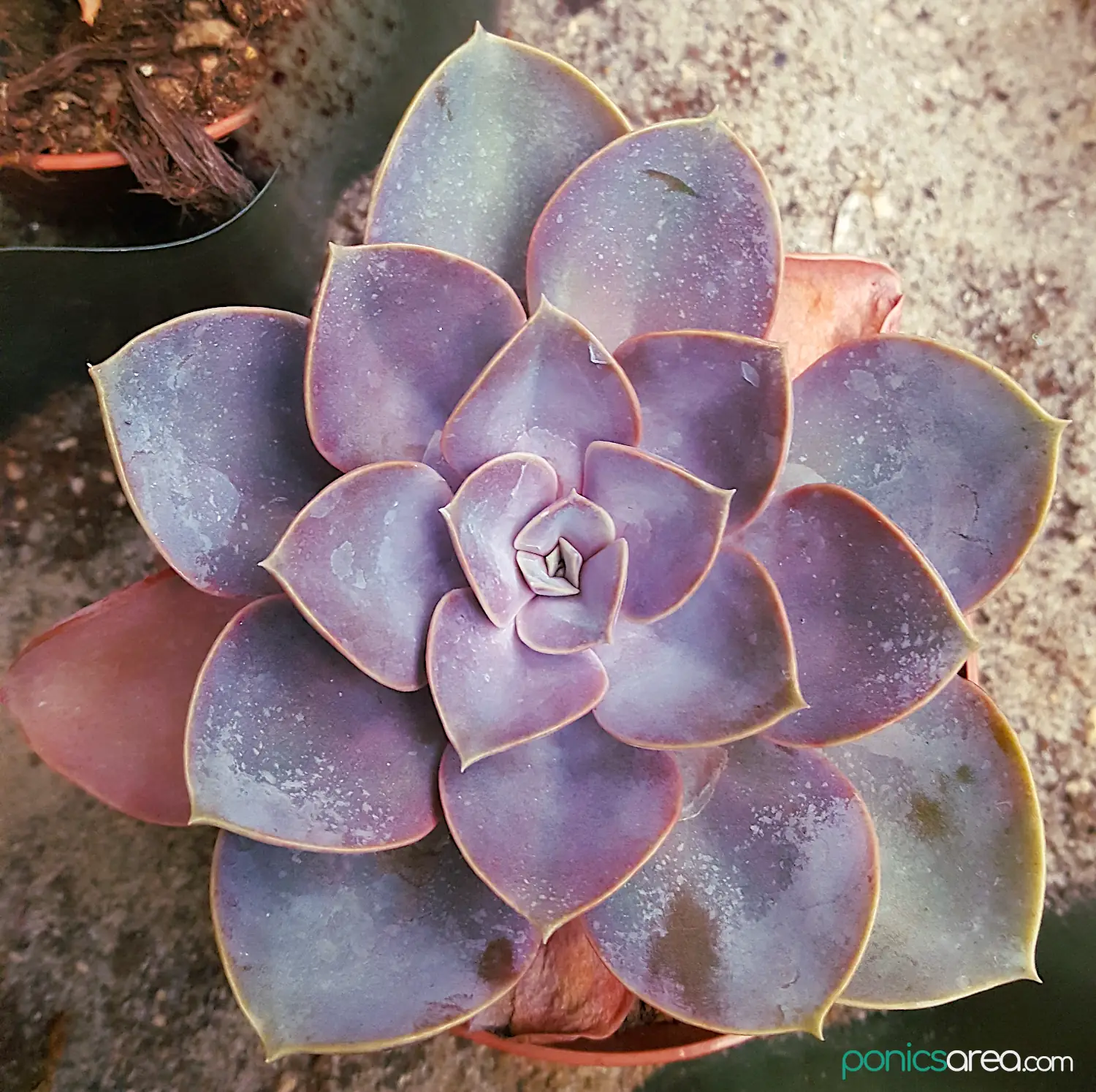
When it comes to succulents with purple flowers, there are a few varieties that are really popular and beautiful, especially in the cacti world.
The other category is that of succulents with leaves that turn purple under certain conditions.
Let’s find out more about these two fascinating categories. You might be interested in both. I think purple leaves can be even more interesting than flowers of the same color, it’s definitely not something you see everywhere you go.
1. Echinofossulocactus Multicostatus (Stenocactus Multicostatus)
First of all, the only way to short this really long name is by calling it E. multicostatus. You could also call it by another name: brain cactus. Another common name is wave cactus.
This type of succulent with purple flowers is actually a cactus and it’s absolutely lovely.
It actually blooms purple striped flowers during spring. It can also have white or pink flowers, you must make sure that you’re getting the purple variety.
When it’s young and has a small green body, there’s another adorable aspect about it: the green body can be upstaged by the dimensions of its flower. I love it the most like that.
As it matures, the body will grow bigger with large waves. The shape is spherical with beautiful spines.
E. multicostatus can be grown in group plantings with other cacti. Another good news is that the Echinofossulocactus family includes members that are easy to grow and very strong.
How to care for E. multicostatus (brain cactus):
- place in a well-lit spot
- water regularly all year long
- allow the soil to dry out almost completely before thoroughly watering again
- during summer, if the light is too strong and the weather too hot, water more often because they get sunburned
- the bloom period takes place during spring
2. Gymnocalycium Baldianum (Chin Cactus)
The chin cactus can actually have a variety of flowers: white, pale pink, vivid pink, scarlet and purple.
If you’re keen on growing succulents with purple flowers and you run across the chin cactus, you must make sure that you get the desired color.
The Gymnocalycium family has beautiful multilayered flowers and their skin is just as interesting, looking similar to reptile skin.
How to care for Gymnocalycium Baldianum:
- wait for the soil to get dry between watering – thoroughly water then
- if you don’t give it enough water, the skin will become squishy, it loses firmness
- give it plenty of water until it recovers if you notice that it has stopped growing and the skin has lost its gloss
- has a strong nature, it grows easily
- can grow in relatively low light
- place it in a well-ventilated spot
3. Aptenia Cordifolia (Red Apple)
Let’s talk about one of the few succulents with purple flowers that is not a cactus. Which is also known as a love charm.
It has daisy-like flowers that can be either purple, pink, red, yellow or white. Pick the one you like best.
The flowers will only stay open during the day and go to sleep at night. The flowers close at night.
How to care for Aptenia Cordifolia:
- water only when it gets dry, it doesn’t like much water and it will grow even without water, especially in the winter
- since it doesn’t love water, it’s prone to root rot
- use gritty, well-draining soil
- there’s absolutely no need to use fertilizer
- in order to shape it, trim it – the cuttings can be immediately replanted
- can climb around other plants
4. Anacampseros Rufescens (Sand Rose)
This is a very small succulent with purple flowers that can have amazing leaves in full sun. The leaves can also have pinks and purples on the bottom.
So, it’s a purple flower with purple leaves succulent.
The flowers can also be pink or violet.
It blooms in the spring but the buds will open only on sunny days with temperatures of at least 85 degrees Fahrenheit (29 degrees C). Those are not easy conditions to achieve.
How to care for Anacampseros Rufescens:
- drought-tolerant, just water it when it’s dry and ensure good drainage
- bring it inside during the cold months, it will die from frost
- very easy to propagate from seed
5. Plectranthus Neochilus (Lobster Flower)
This must be one of the most interesting succulents with purple flowers because it can be easily identified by its smell. Some people will love it, while others maybe not so much.
The blooms can be actually expected throughout the year but are more predominant from spring to late fall.
It has deep purple flowers that can reach an impressive 3 to 6 inches height.
The thing is that it can only be grown outdoors so, it’s not for those living in apartments. There aren’t that many succulents that can’t be grown in a pot. The Plectranthus Neochilus is one of those.
On the other hand, it’s perfect for dry places that receive little rain. It will be happy only receiving winter rains. Just prune it to maintain its shape, after the blooms dry.
If you live somewhere with water restriction, the Lobster Flower is a choice that’s just as perfect as lavender. Lavender just smells better.
6. Conophytum (Stone Plants, Living Pebble)
Stone Plants are some of the most interesting varieties and not just because they’re succulents with purple flowers.
There are many variations of a ball with two leaves attached to it.
The ball can be round, oval or pocket shapes.
Moreover, it blooms in winter. That’s when it grows and it actually rests in the spring and summer. Naturally, that makes it vulnerable to heat. Conophytum is an unusual family from that point of view. Most succulents will rest in winter and bloom in spring.
The flowers can be red, white, yellow, and purple.
How to care for Conophytum:
- let it rest during summer and don’t water it – don’t place it in a spot that’s too bright
- you can water regularly in the fall and throughout winter when the soil gets dry
- in the fall, it’s time to place it in a well-lit spot so that it grows strong
- actively grow from fall to winter
- it needs good ventilation
7. Aeonium Arboreum Zwartkop (Black Beauty, Purple Crest Aeonium)
The Purple Crest Aeonium is one of those rare succulents with intense purple leaves that produces yellow flowers.
It’s a stunner but I must warn you: it can take years for a rosette to flower. It’s not a good choice for those who want regular results during blooming season.
The The Purple Crest Aeonium has large 6-8 inches rosettes that sit atop thin bare stems. The rosettes are all the focus, especially when there are flowers that protrude out from their center.
The rosettes have a dual appearance. They can be darker and even more impressive in full sun. In full shade, we have purplish leaves with a green center.
The other peculiarity is that it can be only grown outdoors.
Once it flowers, it dies. But it’s worthy it, if you want to see hundreds of yellow flowers in the center of a single rosette. The flowers will last longer than a month.
If only a branch blooms, then only that branch dies. There might be many branches that will bloom throughout different years so, it can be a long-lasting plant after all.
8. Senecio Crassissimus (Lavender Steps, Lavender Lips, Vertical Leaf Senecio)
The Vertical Leaf Senecio has upright, stiff purple stems with flat, glossy leaves that are greenish-blue and purple at the edges.
It can thrive under hot sunlight and that’s when the coloring intensifies.
You can grow it both indoors and outdoors.
Plus, to make it even more perfect, the Vertical Leaf Senecio blooms during winter. It has bright yellow, shaped like daisies flowers.
How to care for Senecio Crassissimus:
- pruning is actually one of the most important aspects of taking care of the Vertical Leaf Senecio, which is not something we hear that often when it comes to succulents
- it will reach its maximum height in a few seasons, which means that in the spring you’ll have to prune about 6-8 inches to prevent it from getting floppy on top
- you can plant those cuttings when the stems scab and get even more plants – it can be a wonderful idea for a gift
- like lavender, it will thrive in sandy soils with excellent drainage
- you can use an annual fertilizer
9. Lavender Pebbles (Jewel Leaf Plant, Moon Rocks)
Just by the name, you can easily tell that this is a succulent with purple leaves. The Latin name is actually Graptopetalum amethystinum.
The leaves are plump, tiny, and round. Their coloring, comprised of hues of pink, violet, purple and silver, can be considered even more attractive than the above succulents with purple flowers.
To complete the charming effect, there’s a powdery coating on its leaves. It looks best when a large number of plants are grown together in a large clump.
How to care for Lavender Pebbles:
- likes some shade in very hot regions but it can be healthy in full sun to partial sun
- moderate watering during spring and summer
- during the cold months you should ensure that the soil is mostly dry, not much watering is needed
- the spring blossoms are star-shaped and yellow, the blooming continues in the summer and fall
- in the winter, if you’re in a colder region, cover with frost cloth if you’re growing it outdoors; if it’s in pots just move it indoors
10. Graptoveria Opalina
Opalina is another succulent with some purple on its leaves, especially towards the edges.
The colors get more pronounced under bright direct sun so, ensure that it receives plenty of time in the sun if you want to see those beautiful leaves adorned with swirls of blues, greens and purples.
It’s actually a hybrid of the above Lavender Pebbles and the care is pretty much the same.
11. Crassula Pellucida Variegata (Crassula Calico Kitten)
How could we not be interested in something that’s called Crassula Calico Kitten? Even if it’s not a succulent with purple flowers but one with purple leaves.
The small stacked heart-shaped leaves are gorgeous, especially with their shades of purple, red, cream, and green.
The awesome news?
Crassula Pellucida Variegata actually needs very little care once established. You need to trim the flowers when they dry.
When it blooms, it has white tiny firework flowers that will further accentuate the beauty of its leaves.
You’ll be able to tell its mood because it turn reddish-purple if stressed. Just keep it dry and never let it sit in water. And protect it from frost, it loves warmth.
12. Euphorbia Ferox
Let’s talk about a succulent that doesn’t have a purple body or purple flowers but purple spines.
The purple spines inspire an even more threatening look that doesn’t stop its entire appearance from being fascinating.
The Euphorbia Ferox has a small size and, even though it has spines, it doesn’t belong to the cacti family because it doesn’t have areoles on its surface. Cacti are distinguished from other succulents by the presence of areoles.
In the case of succulents like the Euphorbia, the spines are their flowers that have changed through evolution.
How to care for Euphorbia Ferox:
- ensure regular watering all year long
- if watering stops, it stops growing even if you water it properly afterwards
- during winter, it should be grown indoors in warm temperatures, it’s very sensitive to cold
- avoid root rot by having a well-drained soil and by placing it in a well-ventilated spot during summer
How to Care for Succulents
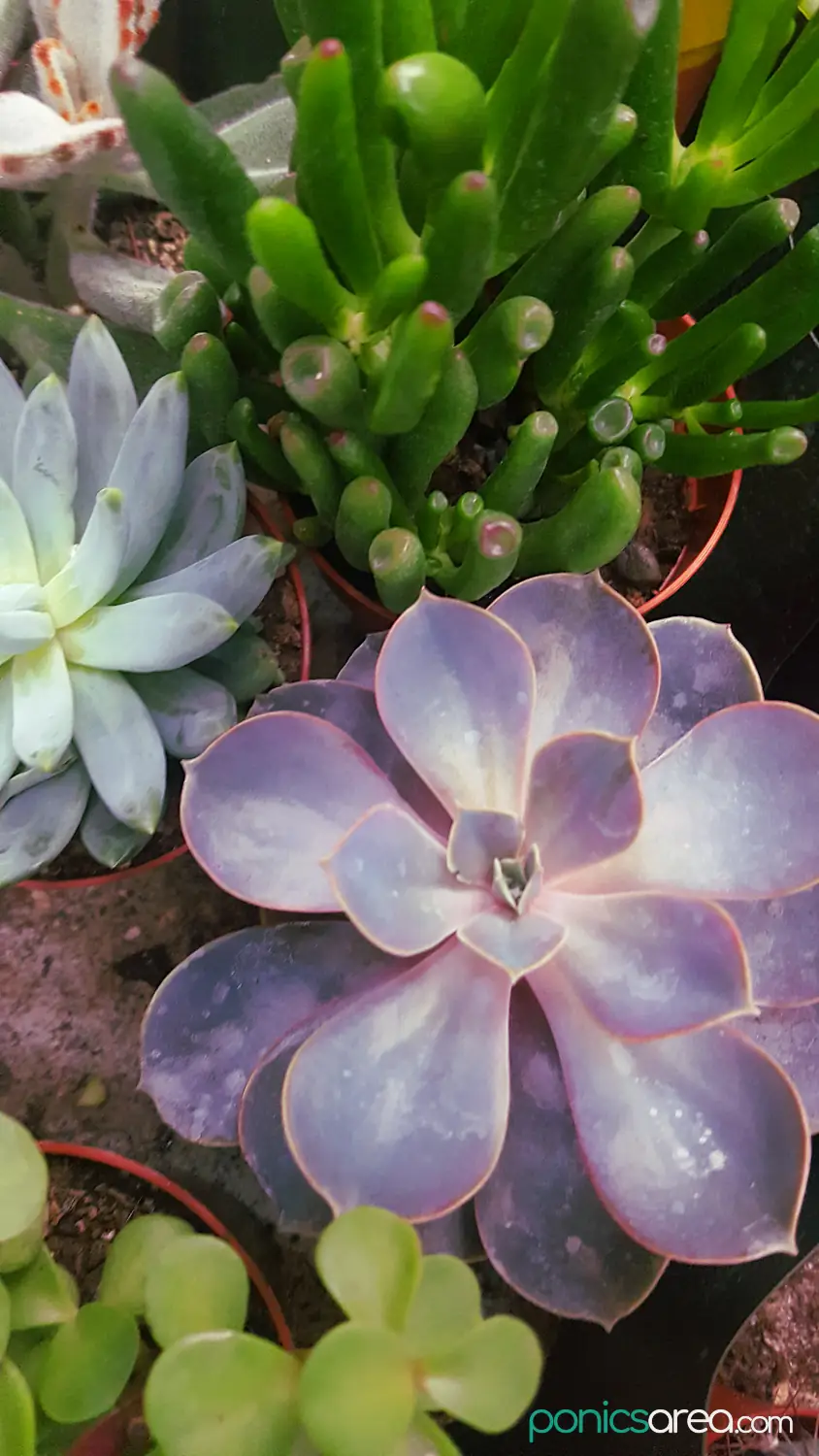
Succulents have many benefits, including some being absolutely delicious, like dragon fruit or pineapple. Others improve the air we breath, like the Snake plant. Or benefit our skin, aloe vera being the most popular example.
Since cacti are part of this world, these plants are very famous for how little maintenance they need. Does that apply to varieties that bloom? We’ll have to see about that.
I tried to provide a bit of information on the care for each variety of succulents with purple flowers or purple leaves as I introduced them to you above. Let’s expand on that.
This simple guide doesn’t only apply to succulents with purple flowers but to all of them.
Sunlight
- most will require a bright, luminous spot – they will want as much direct sunlight as they can get, indoors and outdoors
- morning sun is preferred because it’s less hot and harsh
Soil
- best soil: chunky, well-draining, that doesn’t hold water, with little organic matter – if you’re using one rich in compost, it will hold a lot of water
- there is something called cactus soil/mix that works for all succulents
- you can also make it home from a mix of potting soil with pumice/vermiculite and small pebbles
- you can also add mulch, moss, pebbles at the top of the soil
Watering
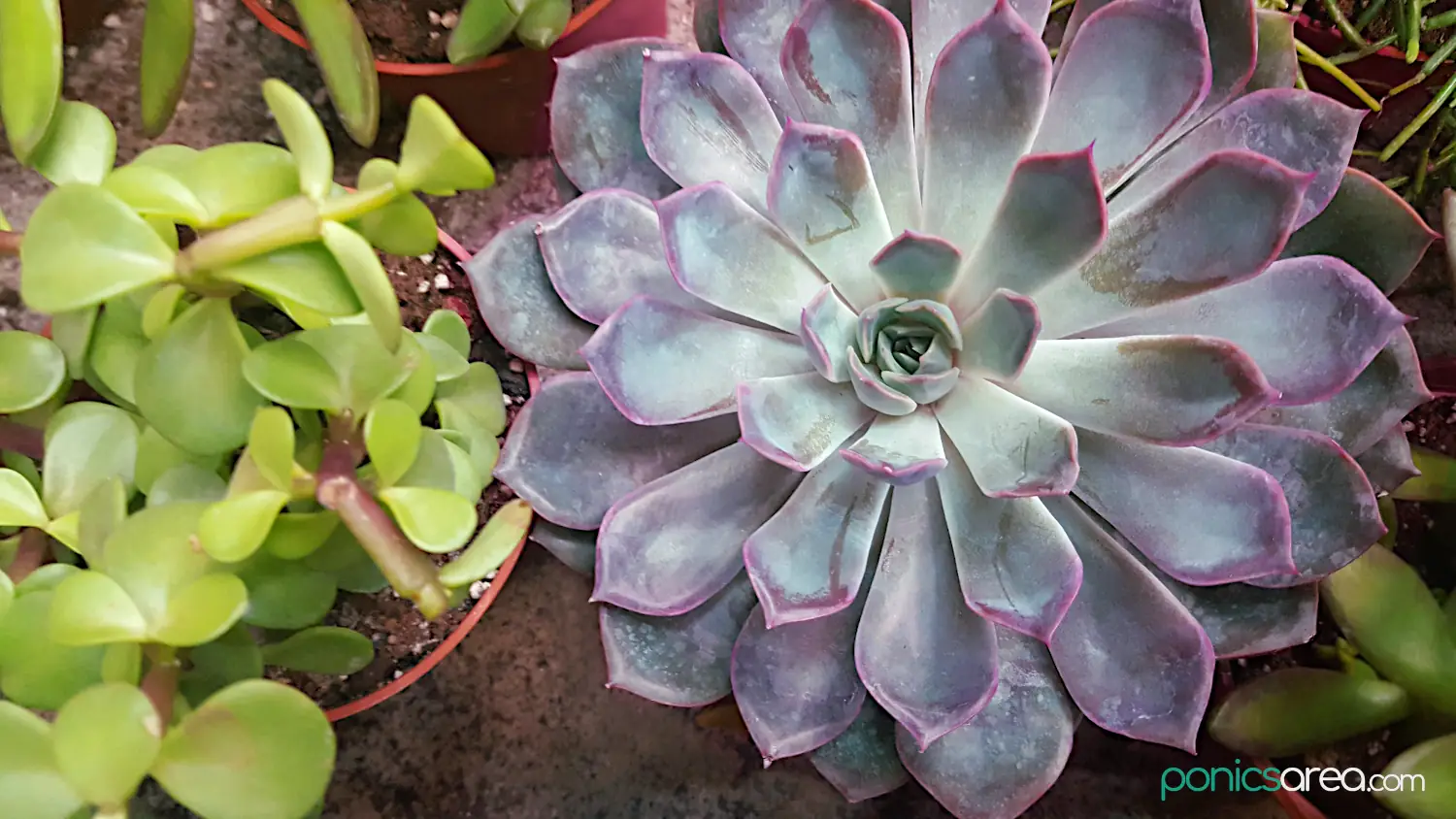
- ensure drainage holes for potted succulents – if there is a dish below the pot to catch the excess water, empty it once the water drains to prevent the plant from absorbing the excess
- succulents like to be dry before they are thoroughly watered – the best way is to touch the soil and, if it’s moist, leave it alone
- if it’s dry 2 inches down, then you can pour water
- cacti will do very well indoors as long as you don’t overwater them – most are prone to root rot
- yellowed leaves are an indicator of overwatering and underwatering, just like with herbs
- small plants should be watered once every 7-10 days – decrease frequency as they grow bigger
- on average: water every 2 weeks in the spring and summer and once every 3-4 weeks in the winter
You can also check out my article on how often to water succulents.
Fertilizer can be used twice a year: during early spring to encourage those succulents with purple flowers and other colors to bloom and during fall as protection against harsh winters.

